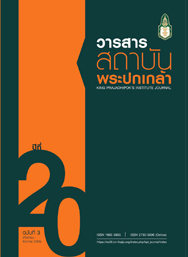International Organizations’ Role on Peace Process and Some Perspectives on Southern Thailand’s Future
Main Article Content
Abstract
This research article is part of the project title “International Organizations’ Role on Peace Process and Some Perspectives on Southern Thailand’s Future” which intends to study of how international actors engage in Southern Thailand’s peacebuilding, and their role in Southern Thailand Peace Process, particularly on the role of third party in formal Peace Dialogue Process that began in 2013.
The research results found that several roles of the international organizations which can be grouped as 1) monitoring peace process 2) creating an environment inductive dialogue and campaigning peace process 3) supporting for academic researches to resolve specific issues, contributing to infra-structure development, contributing development on the education or economic sectors, helping to develop skills relevant to peace dialogue, and helping in major issues such as human rights and international humanitarian principle 4) provisioning and funding capacity building activities 5) playing the role as facilitator in peace dialogue 6) contributing to humanitarian aids and social work. Meanwhile, the role of Malaysia as facilitator is significantly put peace talk forward for Southern of Thailand. Nevertheless, there are many challenges to deal with, for instance, the acceptance from the conflict actors, being trustworthy by the two sides as the third party. Moreover, as being the third party itself, it depends on the Malaysian’s political instability.
In order to brighten the prospect of Peace Dialogue Process, it is necessary to assiduously continue the process with the support of all actors. The research recommends that Thai government should allow a greater participation of international actors to accompany the dialogue and provide capacity building to both government and dissident interlocutors. Also, the government should allow international actors to play a greater role in supporting local people and civil society to be partners in peacebuilding and become more confident in the process.
Article Details

This work is licensed under a Creative Commons Attribution-NonCommercial-NoDerivatives 4.0 International License.
@ 2020 King Prajadhipok's Institute The Government Complex Commemorating All Right Reserved.
References
ภาษาไทย
คณะทำงานยุทธศาสตร์สันติวิธี. (2559). ตัวแสดงระหว่างประเทศในความขัดแย้งถึงตายที่ชายแดนใต้. กรุงเทพฯ: ภาพพิมพ์.
คณะทำงานพื้นที่กลางสร้างสันติภาพจากคนใน. (2556). ริเริ่มพูดคุย: บทประเมินกระบวนการสันติภาพชายแดนใต้/ปาตานีหลังการลงนามในฉันทามติทั่วไปฯ. สืบค้นจาก https://deepsouthwatch.org/th/node/4014
คม ชัด ลึก. (2561). เปลี่ยนตัวผู้อำนวยความสะดวกพูดคุยดับไฟใต้เดินหน้าหรือล่าถอย?. สืบค้นจาก http://www.komchadluek.net/news/scoop/340918
ชาญชัย ชัยสุโกศล, ผู้เรียบเรียง. (2554). ใน โคทม อารียา (บรรณาธิการ), ภาพอนาคตจังหวัดชายแดนใต้, (น. 8-9). นครปฐม: ศูนย์ศึกษาและพัฒนาสันติวิธี (ศพส) มหาวิทยาลัยมหิดล.
บีบีซีไทย. (16 ตุลาคม 2561). เจรจาดับไฟใต้ ไปต่ออย่างไรในช่วงท้ายรัฐบาลทหารไทย. สืบค้นจาก https://www.bbc.com/thai/thailand-45872714
วีเลอร์, แมตธิว. (2551). สหรัฐอเมริกา สงครามต่อต้านการก่อการร้าย และความรุนแรงในชายแดนภาคใตของประเทศไทย. ใน ชัยวัฒน์ สถาอานันท์ (บรรณาธิการ), แผ่นดินจินตนาการ (น. 475-546). กรุงเทพฯ: มติชน.
รุ่งรวี เฉลิมศรีภิญโญรัช. (2558). เส้นทางกระบวนการสันติภาพปาตานี. ปัตตานี: สถาบันสันติศึกษา มหาวิทยาลัยสงขลานครินร์ โครงการเสริมสร้างความเข้มแข็งและการมีส่วนร่วมในภาคใต้ของไทย (STEM).
ศรีสมภพ จิตร์ภิรมย์ศรี. (2562). อัลกอริทึมของความแปรปรวนในความรุนแรง 15 ปีชายแดนใต้/ปาตานี. สืบค้นจาก https://www.the101.world/algorithm-of-violence-in-deep-south/
ศูนย์ข้อมูลมติชน. (2556). บันทึกประเทศไทย 2556. กรุงเทพฯ: มติชน.
สำนักข่าวอิศรา. (2562). 15 ปีไฟใต้...หมุดหมายสันติสุข?. สืบค้น https://www.isranews.org/south-news/talk-with-director/72582-fif.html
อิสมะรูปายดะห์ ดอเลาะ. (2557). ไทยยอมรับมาเลเซียเป็นคนกลางสร้างสันติภาพ. สืบค้นจาก https://deepsouthwatch.org/dsj/th/6468.
ภาษาอังกฤษ
Armengol, V.F. (2013). The Principles of Mediation and the Role of Third Parties in Peace Process. Retrieved from https://noref.no/Publications/Themes/
Peacebuilding-and-mediation/The-principles-of-mediation-and-the-role-of-third-parties-in-peace-processes
Child, J. (1999). The Central American Peace Process: The Role of International Organizations. Retrieved from https://go.gale.com/ps/i.do?id=
GALE%7CA64687873&sid=googleScholar&v=2.1&it=r&linkaccess=abs&issn=1525125X&p=AONE&sw=w&userGroupName=anon%7Eb208f53e
Conciliation Resources. (n.d.). International Contact Group on Mindanao. Retrieved from https://www.c-r.org/our-work-in-action/international-contact-group-mindanao
Franco, F. (2013). Malaysia: Unsung Hero of the Philippine Peace Process. Asian Security, 9(3), 211-230. DOI: 10.1080/14799855.2013.832210
Mason, S.A & Siegfried, M. (2007). Mediation & Facilitation in Today’s Peace Processes: Centrality of Commitment, Coordination and Context. Retrieved from https://www.files.ethz.ch/isn/87121/OIF-Mediation_and_Facilitation_
in_Peace_Processes_15-17_Feb_2007.pdf
Moolakkatu, J.H. (2005). Peace Facilitation by Small States: Norway in Sri Lanka. Cooperation and Conflict, 40(4), 385-402.
Na Thalang, C. (2017). “An Honest Broker?” Malaysia’s Role in Two Southeast Asian Insurgencies. Australian Journal of International Affairs, 71(4), 389-404. Retrieved from https://www.tandfonline.com/eprint/KUirPz44Xi293BwnsQgc/
full?target=10.1080/10357718.2016.1269147


